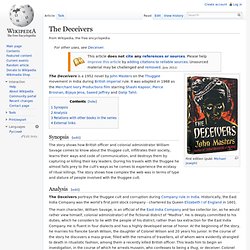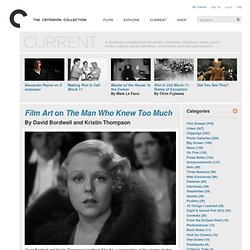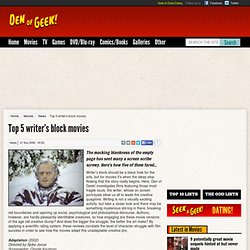

The Deceivers. Synopsis[edit] The story shows how British officer and colonial administrator William Savage comes to know about the thuggee cult, infiltrates their society, learns their ways and code of communication, and destroys them by capturing or killing their key leaders.

During his travels with the thuggee he almost falls prey to the cult's ways as he comes to experience the ecstasy of ritual killings. The story shows how complex the web was in terms of type and stature of people involved with the thuggee cult. Analysis[edit] National Novel Writing Month. Pixar's 22 Rules of Storytelling Presented with Film Stills from Pixar Films. ©2012 Disney/Pixar.

Back in 2001, former Pixar story artist Emma Coats tweeted this series of "story basics" in 2011. An Interview with Robert McKee. Q: Are there basic components to what makes for a compelling story?

Robert McKee: This question literally takes 500 pages of my book Story to answer. It is the equivalent of asking a question such as, "What are the basic components of music? " or "What are the basic components of painting? " Trying to determine what is basic is very difficult. Some people, for example, think dialogue is a basic component of story. But let me try to answer that question by making a simple and clear definition of story itself. Q: How important is the process of rewriting? Robert McKee: It's absolutely critical. Q: Quentin Tarantino once said, "The thing that distinguishes an American artist is his capacity to tell a good story. " Robert McKee: I generally would agree with Tarantino, but only in a limited way. Q: Is good storytelling a lost art? Robert McKee: No, I don't think it's a lost art, but I think it has lost energy. Q: You use the words "story design" frequently.
When is that moment? A. B. Memento (film) Memento is presented as two different sequences of scenes: a series in black-and-white that is shown chronologically, and a series of color sequences shown in reverse order.

The two sequences "meet" at the end of the film, producing one common story.[3] It stars Guy Pearce as Leonard Shelby, a man with anterograde amnesia, which impairs his ability to store new explicit memories, who has developed a system for recollection using hand-written notes, tattoos, and Polaroid photos. During the opening credits, which portray the end of the story, it is shown that Leonard kills Teddy (Joe Pantoliano). The film suggests that this killing is vengeance for the rape and murder of his wife (Jorja Fox) based on information provided by Natalie (Carrie-Anne Moss). A backwards sequence is shown. It starts with the Polaroid photograph of a dead man. The black-and-white sequences begin with Leonard Shelby in a motel room speaking to an unnamed telephone caller who is not shown on-screen. Film Art on The Man Who Knew Too Much. David Bordwell and Kristin Thompson’s textbook Film Art, a cornerstone of the cinema studies discipline, was first published in 1979 and is now in a tenth edition.

Over the years, some sections have been taken out, either to make room for new content or because the films they treated were no longer in circulation. Among these dropped pieces is the authors’ analysis of Alfred Hitchcock’s 1934 The Man Who Knew Too Much. With permission from Bordwell and Thompson, it is republished here (from the 1988 second edition, in which it last appeared), illustrated with images and film clips from the recent Criterion release of the film. See Bordwell’s related blog post here. Like His Girl Friday, The Man Who Knew Too Much presents us with a model of narrative construction. Our analysis may begin by noting the obvious.
It is instructive to observe how the narrative’s three major sections smoothly link plot events together. A rising sun and “Wapping G. Books. Film Art: An Introduction by David Bordwell and Kristin Thompson about the bookFilm Art: An Introduction is a survey of film as an art form.

It’s aimed at undergraduate students and general readers who want a comprehensive and systematic introduction to film aesthetics. It considers common types of films, principles of narrative and non-narrative form, basic film techniques, and strategies of writing about films. It also puts film art in the context of changes across history. Film Art first appeared in 1979 and is currently in its tenth edition, published by McGraw-Hill. Top 5 writer's block movies. Writer's block should be a black hole for the arts, but for movies it's when the ideas stop flowing that the story really begins.

Here, Den of Geek! Investigates films featuring those most fragile souls, the writer, whose on screen portrayals allow us all to wade the creative quagmire. Writing is not a visually exciting activity, but take a closer look and there may be something mysterious stirring in there, breaking old boundaries and opening up social, psychological and philosophical discourse. Authors, however, are hardly pleasantly identifiable creatures, so how engaging are these movie versions of the age old creative stump? 20 Greatest Movies About Writers - GeekWeek. I first came to Los Angeles many years ago with the hopes of doing a lot of writing, but instead I did a lot of walking.

Given the profoundly accustomed car culture of the landscape, I was an anomaly as I walked everywhere and glimpsed at apartments I would never live in, restaurants I wanted to eat at but never got around to, and bars where I wanted to drink at with friends I didn’t have yet. Los Angeles was my compromise, one of many in a lifetime. Los Angeles is the city where people who are too afraid to go to New York end up, in the same way that Chicago is the city where people who are too afraid to go to Los Angeles end up. But in my heart, New York was supposed to be mine.